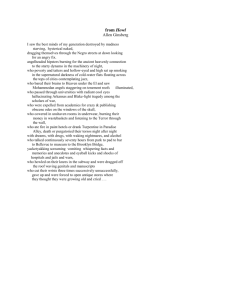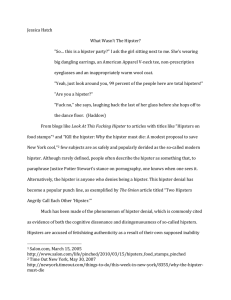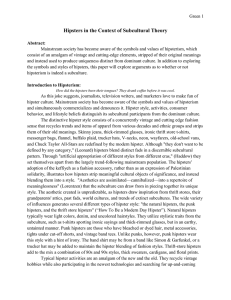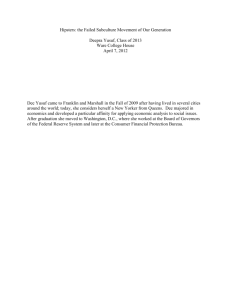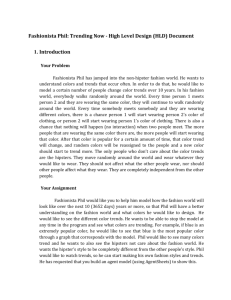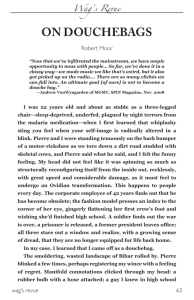HIPSTER FINAL
advertisement
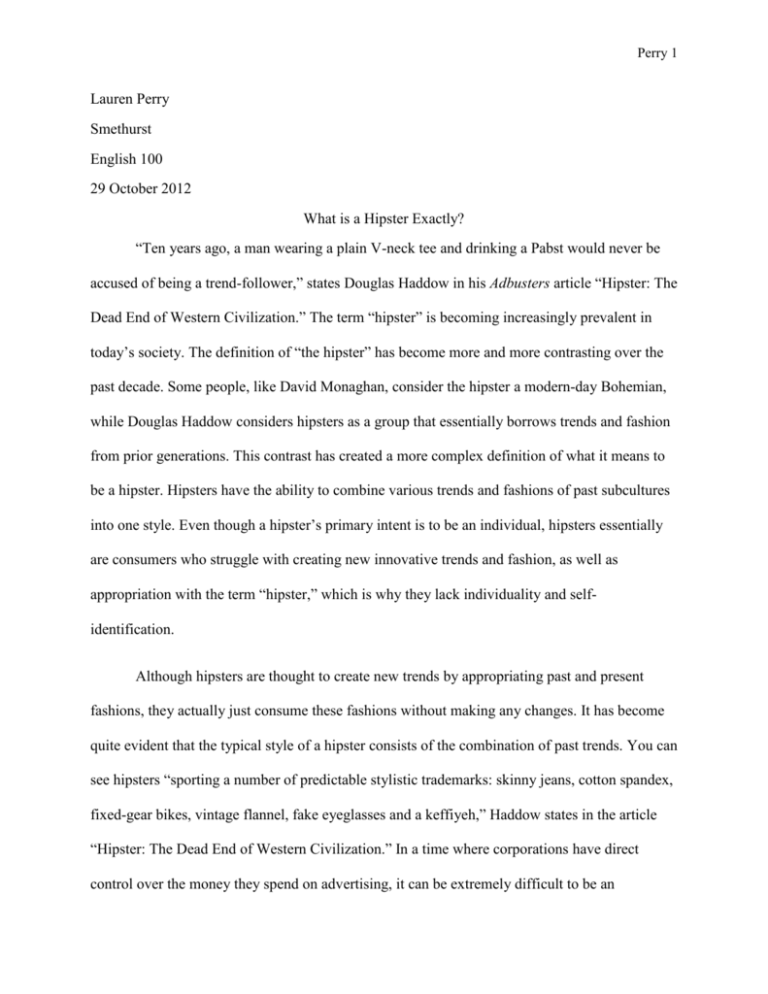
Perry 1 Lauren Perry Smethurst English 100 29 October 2012 What is a Hipster Exactly? “Ten years ago, a man wearing a plain V-neck tee and drinking a Pabst would never be accused of being a trend-follower,” states Douglas Haddow in his Adbusters article “Hipster: The Dead End of Western Civilization.” The term “hipster” is becoming increasingly prevalent in today’s society. The definition of “the hipster” has become more and more contrasting over the past decade. Some people, like David Monaghan, consider the hipster a modern-day Bohemian, while Douglas Haddow considers hipsters as a group that essentially borrows trends and fashion from prior generations. This contrast has created a more complex definition of what it means to be a hipster. Hipsters have the ability to combine various trends and fashions of past subcultures into one style. Even though a hipster’s primary intent is to be an individual, hipsters essentially are consumers who struggle with creating new innovative trends and fashion, as well as appropriation with the term “hipster,” which is why they lack individuality and selfidentification. Although hipsters are thought to create new trends by appropriating past and present fashions, they actually just consume these fashions without making any changes. It has become quite evident that the typical style of a hipster consists of the combination of past trends. You can see hipsters “sporting a number of predictable stylistic trademarks: skinny jeans, cotton spandex, fixed-gear bikes, vintage flannel, fake eyeglasses and a keffiyeh,” Haddow states in the article “Hipster: The Dead End of Western Civilization.” In a time where corporations have direct control over the money they spend on advertising, it can be extremely difficult to be an Perry 2 individual when you can only consume what is being advertised and sold in stores. By hipsters being consumers, they use “their capital to purchase empty authenticity,” Haddow states in his article. Some might say that combining prior trends into one style is originality because it has not been done before, but consumption of these past and present fashion trends does not allow hipsters to be authentic. Hipsters have the accessibility to buy into whatever is being sold in clothing stores, just like most consumers do. Because of this, hipsters have the inability to create anything that hasn’t already been done before. If something meant for consumption has already been created, I don’t feel that it can be seen as something new. Hipsters lack of individuality stems from their common tendency to incorporate past trends into the present. Hipsters are primarily known for this tendency because it has become so prevalent in today’s society. In the Society Pages online article “Hipster Rivivalism: Authentic Technologies of Days Gone Past,” by Dave Paul Strohecker, the author explains how hipsters look to the past as a source of authenticity because of their desire to differentiate themselves from mainstream society. This assertion explains why hipsters continue to include past trends in present-day society. Even though this article gives reference to hipsters’ intention to stand out or be different, it fails to mention how this desire to be different has turned into something so common. The rise of the subculture has created a commonality and has in fact become a part of mainstream society, because so many people are following the hipster trend. Because the subculture has become so common, the individual aspect of the culture has lessened. By only consuming and failing to create anything new, hipsters continue to utilize the past to combine bits and pieces into the present. This attempt to create something new with the past demonstrates lack of individuality because it is still essentially incorporating trends that have already been made. Perry 3 Due to the hipster’s intent to be an individual, hipsters have often denied affiliation with the label placed upon them, which is why they struggle with self-identification. This struggle of self-identity prevents them from defining who they are as individuals as well as a subculture. Haddow describes a scenario he encountered at a hipster party in the city when he asked a girl if she was a hipster and she blatantly responded by denying the fact that she was a hipster, even though everything about her resembled a hipster. This example conveys the idea that hipsters do in fact have issues with self-identification. In Dave Monaghan’s article, “In Defense of Hipsters,” Monaghan states that “There are very few, if any, self-avowed hipsters.” An opposing view might saw that hipsters do not want to be associated with this label because of the negative connotation that comes with it. Non-hipsters may have a pre-existing notion of what it means to be a hipster, whether good or bad. All of the aspects associated with the term might scare some and prevent others from wanting to own up to this association. The struggle of self-identifying can stem from several factors. Hipsters are often times teens and young adults who are still trying to find themselves in this confusing and chaotic world. It can be difficult to identify yourself as part of a particular group without knowing who you really are. Hipsters may also feel as though they should not be labeled as a part of a particular group, because they feel they should be recognized as an individual. If you cannot identify yourself, it can be difficult to understand who you are as an individual. I don’t feel that hipster’s are creating anything new by combining the past and present, therefore they should not receive recognition for doing so. The whole idea of being a “hipster” has been blown out of proportion, due to the various definitions and interpretations of the term. Dave Monaghan tries to convey the idea that, just like past generations, hipsters “still have goals and values” and should be given credit for believing in something. Yes, hipsters have goals and Perry 4 values just like any other generation, but how can we give them credit on believing in something that has already surpassed before their time? That’s almost like giving someone credit for someone else’s invention. All hipsters are essentially doing is recycling old ideas and combining them to call it their own. I don’t feel that hipsters deserve justification or even acknowledgement for unoriginality. No characteristics of the hipster resemble anything new or innovative. With the contrasting definitions of what it means to be a hipster, it can be hard to specifically identify the subculture. Hipsters essentially are consumers who incorporate and combine the trends and styles of past generations without creating anything new. The components of this lifestyle can lead to lack of individuality and self-identification due to utilizing unoriginal aspects of the past. I don’t feel that hipsters should be given recognition for combining elements of the past and present because it is not creating any new or innovative. I don’t think that being a “hipster” is a bad thing, people should dress and act however they please and do what makes them most happy. The struggle of self-identification within the subculture can create slight confusion when identifying who exactly is a hipster and what kind of people identify themselves as a part of the culture. Although you cannot give hipsters credit for originality or identification, you also cannot suppress them for trying to be an individual in a world of commonality and consumption. Perry 5 Works Cited Haddow, Douglas. “Hipster: The Dead End of Western Civilization.” Adbusters.com. Adbusters Media Foundation. 29 Jul. 2008. Web. 27 Sept. 2012 Monaghan, Dave. “In Defense of Hipsters.” Towardfreedom.com. Toward Freedom. 10 Sept. 2008. Web. 1 Oct. 2012 Strohecker, Dave Paul. “Hipster Rivivalism: Authentic Technologies of Days Gone Past.” Thesocietypages.org. The Society Pages. 25 Nov. 2011. Web. 27 Oct. 2012

